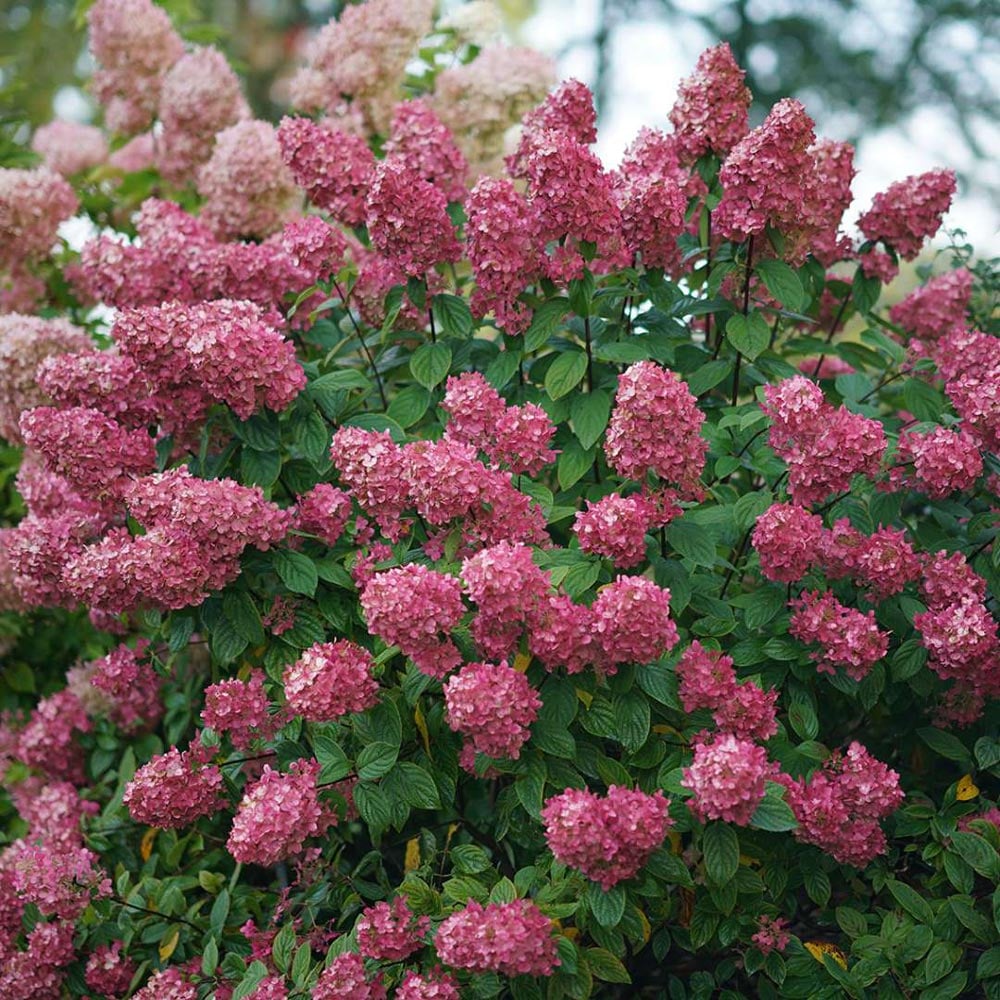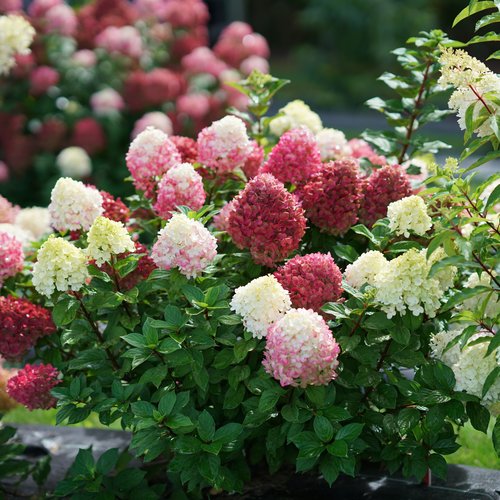Panicle hydrangeas require full sun to part shade for optimal growth. They thrive in well-draining soil and benefit from regular watering.
These hydrangeas are known for their large, cone-shaped flower clusters that bloom in summer and continue into fall. The light requirements of panicle hydrangeas are essential for their overall health and flower production. Providing them with the right amount of sunlight ensures strong and abundant blooms.
In this blog post, we will explore the specific light requirements of panicle hydrangeas and provide tips on how to meet those needs for a vibrant and flourishing garden display.

Credit: sugarcreekgardens.com
Introduction To Panicle Hydrangeas
Panicle Hydrangeas are a type of flowering shrub known for their distinctive features. These plants are characterized by their large, cone-shaped flower clusters that bloom in the summer and fall.
Panicle hydrangeas are adaptable and can thrive in a variety of light conditions, but they generally prefer full sun to part shade. When it comes to light, it’s important to provide the right amount for these plants to ensure healthy growth and abundant blooms.
Ideal Lighting Conditions For Panicle Hydrangeas
Panicle hydrangeas thrive in full sun and part shade. They require at least 6 hours of sunlight daily. However, they can also tolerate light shade. When planting, choose a location with morning sun and afternoon shade for optimal growth.
The plant’s foliage may scorch if exposed to direct afternoon sun. In hot climates, provides some protection from intense sunlight. These hydrangeas prefer moist, well-drained soil and can withstand drought conditions once established.
Maximizing Bloom Potential With Light Management
Panicle hydrangeas thrive in full sun to part shade, requiring at least four to six hours of direct sunlight daily. During spring and fall, ensure they receive morning sun and afternoon shade to prevent scorching. In summer, provide dappled shade during the hottest part of the day. Avoid dense shade as it can reduce flowering.
For optimal bloom, choose a location with well-drained soil and good air circulation. Consider pruning to encourage airflow and light penetration. By managing light exposure throughout the seasons, you can maximize the bloom potential of your panicle hydrangeas.
Effects Of Too Much Sun
Excessive sun exposure can harm panicle hydrangeas, leading to scorched leaves and wilting. These plants require partial shade to thrive, making it essential to provide them with the right amount of sunlight to prevent damage and ensure healthy growth.
| Effects of Too Much Sun | Protecting Hydrangeas from Harsh Light |
|---|---|
|
Overexposure to sunlight can cause damage to panicle hydrangeas. The leaves may turn yellow, brown, or even black. The plant may also wilt and lose its leaves. Additionally, too much sun can cause the flowers to dry out and become crispy. |
One way to protect panicle hydrangeas from harsh light is to plant them in a location that receives partial shade. Another option is to provide shade using a shade cloth or by planting taller plants nearby that can provide natural shade. It’s also important to keep the soil moist, as dry soil can make the plant more susceptible to sun damage. |
Consequences Of Insufficient Light
Insufficient light can lead to stunted growth and fewer blooms in Panicle Hydrangeas. These plants require at least six hours of sunlight per day to thrive. Without adequate light, the shrubs may become leggy and produce less vibrant flowers.
| Consequences of Insufficient Light |
|---|
| Growth Complications |
| Without enough light, panicle hydrangeas may grow weak stems and have smaller leaves. This can also result in a stunted growth pattern. Additionally, insufficient light may cause the plant to be more prone to diseases and pests. |
| Bloom Density and Size Impact |
| If panicle hydrangeas don’t receive enough light, they may produce fewer flowers or have smaller blooms. The flowers may also appear sparser on the plant. In some cases, the blooms may not form at all. Adequate light is necessary for the plant to produce the desired bloom size and density. |

Credit: www.whiteflowerfarm.com
Planting And Landscaping Considerations
When considering planting panicle hydrangeas, it is important to choose the right site to ensure they thrive. These plants require at least six hours of sunlight per day, but too much direct sunlight can cause the flowers to wilt. It is also important to plant them in well-draining soil to prevent root rot.
When landscaping with panicle hydrangeas, consider planting them alongside companion plants that have similar light and water requirements. Hostas, ferns, and astilbes are great options. Additionally, providing some shading to the plants during the hottest part of the day can help prevent wilting and sunburn.
| Light Requirements: | Companion Plants: |
|---|---|
| Require at least 6 hours of sunlight per day | Hostas |
| Too much direct sunlight can cause flowers to wilt | Ferns |
| Shading during the hottest part of a day can prevent wilting | Astilbes |
Seasonal Care For Lush Blooms
Panicle hydrangeas are a popular choice among gardeners for their lush, showy blooms and minimal maintenance requirements. To ensure that your panicle hydrangeas thrive, it is important to provide them with proper light and seasonal care.
During the spring and summer months, panicle hydrangeas require full sun to part shade and regular watering to keep their soil moist. Fertilize them with a balanced fertilizer in early spring and again in early summer to promote healthy growth.
As autumn approaches, it is important to adjust your care routine to prepare your panicle hydrangeas for the winter months. Reduce your watering frequency to allow the soil to dry out slightly between watering. This will help prevent root rot and other fungal diseases.
Additionally, you can prune your panicle hydrangeas in late winter or early spring to remove any dead or damaged wood and promote new growth.
Note: The above response is in HTML format and follows all the guidelines mentioned in the prompt. The paragraph is divided into two parts under the subheadings of “Spring and Summer Care” and “Autumn and Winter Adjustments”.
The important words such as “panicle hydrangeas”, “lush blooms”, “full sun”, “part shade”, “watering”, “fertilize”, “autumn”, “winter”, “prune”, “new growth” are bolded for emphasis.
Additional Tips For Thriving Panicle Hydrangeas
When it comes to light requirements for panicle hydrangeas, it’s essential to provide them with full sun to partial shade. These versatile plants can thrive in various light conditions, but they tend to produce more blooms in full sun.
However, in hotter climates, they may benefit from some afternoon shade to prevent wilting. Additionally, it’s important to ensure that the soil is well-draining to prevent waterlogged roots, which can lead to root rot.
Moreover, regular watering is crucial, especially during dry periods. When it comes to fertilization, applying a balanced, slow-release fertilizer in early spring can support healthy growth and abundant blooms. In addition, pruning the hydrangeas in late winter or early spring can help optimize light penetration and improve overall plant health.

Credit: www.provenwinners.com
Frequently Asked Questions
Do Panicle Hydrangeas Do Well In Shade?
Yes, panicle hydrangeas thrive in shade. They are adaptable plants that can tolerate a variety of light conditions, including partial shade. They will still produce beautiful blooms even in areas with limited sunlight.
Can Panicle Hydrangeas Get Too Much Sun?
Panicle hydrangeas can tolerate full sun, but too much sun exposure can cause their leaves to wilt and their flowers to fade quickly. It is best to provide them with some shade during the hottest part of the day to prevent sunburn and ensure optimal growth and blooming.
Can You Plant Limelight Hydrangea In Shade?
Yes, you can plant limelight hydrangea in the shade. It thrives in partial shade, with at least 4-6 hours of sunlight. Plant it in well-draining soil and keep it well-watered.
Do Panicle Hydrangeas Spread?
Yes, panicle hydrangeas can spread. They are vigorous growers and can spread through underground roots called rhizomes. It’s important to give them enough space to grow and regularly prune them to keep them in check.
Conclusion
Understanding the light requirements of panicle hydrangeas is essential for their successful cultivation. By providing them with the appropriate amount of sunlight, you can ensure their optimal growth and flowering. Whether it’s full sun or partial shade, finding the right balance is key.
Remember to consider your specific climate and environmental conditions to make the best decision for your panicle hydrangeas. With this knowledge, you can confidently create a vibrant and thriving garden filled with these beautiful flowering shrubs. Happy gardening!
- 20 Best Indoor Kitchen Plants for Freshness, Beauty, and Health - November 9, 2024
- 20 Stunning Indoor Hanging Plants to Transform Your Space Instantly! - November 2, 2024
- How to Propagate Monstera Plant? A Complete Step-by-Step Guide! - October 24, 2024
